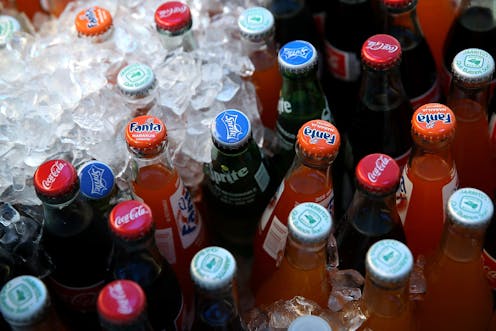Pop, soda or coke? The fizzy history behind America’s favorite linguistic debate
- Written by Valerie M. Fridland, Professor of Linguistics, University of Nevada, Reno

With burgers sizzling and classic rock thumping, many Americans revel in summer cookouts – at least until that wayward cousin asks for a “pop” in soda country, or even worse, a “coke” when they actually want a Sprite.
Few American linguistic debates[1] have bubbled quite as long and effervescently as the one over whether a generic soft drink should be called a soda, pop or coke.
The word you use generally boils down to where you’re from[2]: Midwesterners enjoy a good pop, while soda is tops in the North and far West. Southerners, long the cultural mavericks, don’t bat an eyelash asking for coke – lowercase – before homing in on exactly the type they want: Perhaps a root beer or a Coke, uppercase.
As a linguist who studies American dialects[3], I’m less interested in this regional divide and far more fascinated by the unexpected history behind how a fizzy “health” drink from the early 1800s spawned the modern soft drink’s many names and iterations.
Bubbles, anyone?
Foods and drinks with wellness benefits[4] might seem like a modern phenomenon, but the urge to create drinks with medicinal properties[5] inspired what might be called a soda revolution in the 1800s.
The process of carbonating water was first discovered in the late 1700s[7]. By the early 1800s, this carbonated water had become popular as a health drink[8] and was often referred to as “soda water.” The word “soda” likely came from[9] “sodium,” since these drinks often contained salts, which were then believed to have healing properties.
Given its alleged curative effects for health issues such as indigestion, pharmacists sold soda water[10] at soda fountains[11], innovative devices that created carbonated water to be sold by the glass. A chemistry professor, Benjamin Stillman[12], set up the first such device in a drugstore in New Haven, Connecticut, in 1806. Its eventual success inspired a boom of soda fountains in drugstores and health spas.
By the mid-1800s, pharmacists were creating unique root-, fruit- and herb-infused concoctions[13], such as sassafras-based root beer[14], at their soda fountains, often marketing them as cures for everything from fatigue[15] to foul moods.
These flavored, sweetened versions gave rise to the linking of the word “soda” with a sweetened carbonated beverage, as opposed to simple, carbonated water.
Seltzer[16] – today’s popular term for such sparkling water – was around, too. But it was used only for the naturally carbonated mineral water from the German town Nieder-Selters[17]. Unlike Perrier, sourced similarly from a specific spring in France, seltzer made the leap to becoming a generic term for fizzy water.
Regional naming patterns
So how did “soda” come to be called so many different things in different places?
It all stems from a mix of economic enterprise and linguistic ingenuity.
The popularity of “soda” in the Northeast likely reflects the soda fountain’s longer history in the region. Since a lot of Americans living in the Northeast migrated to California[19] in the mid-to-late 1800s, the name likely traveled west with them.
As for the Midwestern preference for “pop” – well, the earliest American use of the term to refer to a sparkling beverage appeared in the 1840s[20] in the name of a flavored version called “ginger pop.” Such ginger-flavored pop, though, was around in Britain by 1816, since a Newcastle songbook is where you can first see it used in text[21]. The “pop” seems to be onomatopoeic for the noise made when the cork was released from the bottle before drinking.
A jingle for Faygo touts the company’s ‘red pop.’Linguists don’t fully know why “pop” became so popular in the Midwest. But one theory links it to a Michigan bottling company[22], Feigenson Brothers Bottling Works – today known as Faygo Beverages – that used “pop” in the name of the sodas they marketed and sold. Another theory suggests that because bottles were more common[23] in the region, soda drinkers were more likely to hear the “pop” sound than in the Northeast, where soda fountains reigned.
As for using coke generically, the first Coca-Cola[24] was served in 1886 by Dr. John Pemberton, a pharmacist at Jacobs’ Pharmacy in Atlanta and the founder of the company. In the 1900s, the Coca-Cola company tried to stamp out[25] the use of “Coke” for “Coca-Cola.” But that ship had already sailed. Since Coca-Cola originated and was overwhelmingly popular in the South, its generic use grew out of the fact that people almost always asked for “Coke.”
As with Jell-O, Kleenex, Band-Aids and seltzer, it became a generic term[27].
What’s soft about it?
Speaking of soft drinks, what’s up with that term?
It was originally used to distinguish all nonalcoholic drinks[28] from “hard drinks,” or beverages containing spirits.
Interestingly, the original Coca-Cola formula included wine[29] – resembling a type of alcoholic “health” drink popular overseas, Vin Mariani[30]. But Pemberton went on to develop a “soft” version a few years later to be sold as a medicinal drink[31].
Due to the growing popularity of soda water concoctions, eventually “soft drink” came to mean only such sweetened carbonated beverages, a linguistic testament to America’s enduring love affair with sugar and bubbles.
With the average American guzzling almost 40 gallons[32] per year, you can call it whatever you what. Just don’t call it healthy.
References
- ^ American linguistic debates (www.washingtonpost.com)
- ^ where you’re from (www.news5cleveland.com)
- ^ As a linguist who studies American dialects (www.valeriefridland.com)
- ^ with wellness benefits (www.vox.com)
- ^ create drinks with medicinal properties (doi.org)
- ^ Smith Collection/Gado via Getty Images (www.gettyimages.com)
- ^ first discovered in the late 1700s (www.mcgill.ca)
- ^ become popular as a health drink (www.sciencehistory.org)
- ^ likely came from (www.dictionary.com)
- ^ pharmacists sold soda water (www.pharmacytimes.com)
- ^ soda fountains (www.scbeverage.com)
- ^ Benjamin Stillman (www.chicagoreviewpress.com)
- ^ unique root-, fruit- and herb-infused concoctions (doi.org)
- ^ root beer (www.sodaparts.com)
- ^ from fatigue (www.gettyimages.com)
- ^ Seltzer (www.etymonline.com)
- ^ Nieder-Selters (archive.org)
- ^ Hall of Electrical History Foundation/Corbis via Getty Images (www.gettyimages.com)
- ^ migrated to California (doi.org)
- ^ appeared in the 1840s (doi.org)
- ^ see it used in text (www.oed.com)
- ^ Michigan bottling company (www.detroithistorical.org)
- ^ bottles were more common (www.foodbeast.com)
- ^ first Coca-Cola (www.coca-colacompany.com)
- ^ tried to stamp out (doi.org)
- ^ Nostalgic Collections/eBay (i.ebayimg.com)
- ^ it became a generic term (doi.org)
- ^ all nonalcoholic drinks (www.sciencedirect.com)
- ^ Coca-Cola formula included wine (www.discovermagazine.com)
- ^ Vin Mariani (museum.dea.gov)
- ^ sold as a medicinal drink (www.rockymountainsoda.com)
- ^ almost 40 gallons (www.ibisworld.com)
Authors: Valerie M. Fridland, Professor of Linguistics, University of Nevada, Reno



